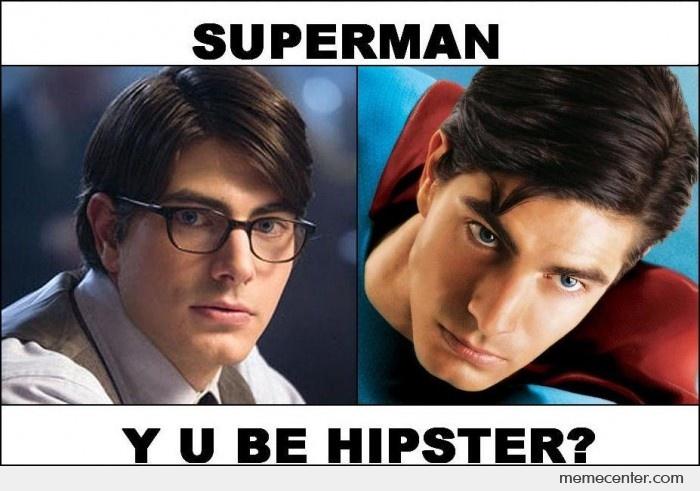The most powerful superhero of all time, Superman, has arguably the worst disguise of all time. A slight application of hair gel and some glasses turn the Man of Steel, the statuesque savior of humanity, into Clark Kent, a mild-mannered reporter at the Daily Planet. It’s a façade that a toddler should be able to see through, but no one does. Why not?
This bizarre failure of perception can only be attributed to Superman’s greatest and perhaps most scientifically astute superpower: He is able to surround himself with friends and co-workers who all suffer from prosopagnosia—face blindness.
Unless you are a comic book aficionado, you may not know that DC Comics did, in fact, try to resolve the issue of his pathetic disguise. In Superman #330, it’s revealed that Superman focuses a hypno-beam through his kryptonite-lensed glasses at everyone he meets. Because Superman is trying to project the persona of Clark Kent—a meek, frail, and “not terribly handsome” version of himself—that is what everyone sees.
But science fiction can do way better than that.
Prosopagnosia is a brain disorder that severely limits a person’s ability to recognize and remember faces. But just faces. Other areas of visual perception remain (mostly) intact. People with face blindness can read, drive, and even realize that what they are looking at is a face. They aren’t even all that socially disabled: They rely on voices, gaits, and typical clothes to identify people. But the ability to recognize a person from the face alone evaporates. In the first recorded case of the disorder, Jean-Martin Charcot (considered by some to be the father of modern neurology) in 1883 described a patient who mistook his own reflection in a mirror for a stranger and apologized for blocking the way. A team of scientists showed a woman with prosopagnosia her own image and asked her what she saw. She responded that it could be one of her neighbors. So for prosopagnosics, Clark Kent is a familiar assortment of suits, nervous mannerisms, and glasses. It’s no wonder nobody at the Daily Planet can match this constellation of clues to Superman in his cape.
The test for face blindness is more straightforward than you might suspect. Mimicking real-world situations, physicians line up a number of people of similar sex, age, and clothing (wearing hats to cover their hair), slipping in a family member or friend of the patient among them. If that familiar person is utterly unidentifiable until he or she speaks, a diagnosis is made. Because many of Clark’s co-workers have seen both him and Superman on the same day without so much as a, “Hey, you remind me of …” they get the same diagnosis.
The disorder that the Daily Planet staff suffers from is extremely rare (affecting an estimated 2.5 percent of the population), but you probably know at least one person with prosopagnosia. Actor Brad Pitt claims that as soon as you turn away from him, you fade from memory; your face never made it in. (There is a quick and dirty test for prosopagnosia online. You can take it here. It tests how well you recognize famous faces—and Brad Pitt is part of the test to test for Brad Pitt’s condition.)
Neuroscientist Oliver Sacks—author of The Man Who Mistook His Wife for a Hat, a case study of visual agnosia—discovered that he, too, had prosopagnosia after mistaking one of his brothers for the other. For many people with disorders like these, the symptoms are taken for granted as simply how the world “looks.” They may not find out that anyone sees faces differently until later in life. For Sacks, it wasn’t until he was 52.
Though some people are born with this disorder, most people who suffer from prosopagnosia acquire it through trauma to certain areas of the brain. A stroke that damages the fusiform gyrus is the most common way to induce face blindness. The gyrus, one on the underside of each hemisphere of your meaty mind, activates in response to faces; when it’s damaged, people rely on patterns and voices instead. But the fusiform gyrus isn’t just a face-recognizer; it helps you make fine distinctions within visually similar categories. In rare cases, bird-watchers and car lovers with lesions to the fusiform gyrus have lost the ability to distinguish types of birds or cars. Likewise, a prosopagnosic can’t distinguish different faces, because within the “face” category a nose is a nose—not Superman’s or Clark Kent’s.
Everything that a prosopagnosic relies on to recognize someone is different for Superman and Clark Kent. His friends and colleagues would be able to recognize one another easily enough, but Superman’s out-thrust chest, booming voice, and festively colored tights would never match that hunched, stammering, bespectacled new reporter.
When venturing outside his special cluster of cognitively impaired colleagues, Superman could keep his identity secret with selective surgery. As his friends, love interests, and co-workers slept, Superman could slip in, X-ray the skull to find the fusiform gyrus, and use his heat vision to lesion it. Clark Kent’s face could never be matched to Superman’s because no one who got a good look at both of them would be able to describe it. Losing facial recognition is a small price to pay to keep Superman forever anonymous.
With his power of super-neuropsychology, Superman has cleverly secluded himself within a rare epidemiological cluster of prosopagnosics. At the Daily Planet, where close observation is part of a reporter’s or photographer’s job description, the hero’s disguise gives nothing away. Nobody recognizes the Man of Steel’s face because they simply can’t perceive it.
[Slate]

